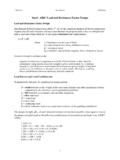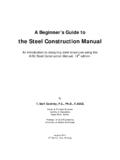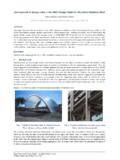Transcription of Calculation of the Plastic Section Modulus Using the Computer
1 Calculation of the Plastic Section Modulus Using the Computer DOMINIQUE BERNARD BAUER ABSTRACT A simple spreadsheet is presented which calculates the plas-tic Section Modulus of structural members. The method con-sists in dividing the cross Section into rectangles and arrang-ing all calculations conveniently into a spreadsheet program. The basic algorithm and the required spreadsheet formulas are given as well as a numerical example. INTRODUCTION With the increasing use of the limit states design of steel structures, engineers often have to calculate the Plastic bend-ing resistance, Mr, of structural members, which is a function of the Plastic Modulus , Z, of the cross Section , that is, M=$ZFy (1) where <|) = performance factor Fy = yield strength of steel.
2 Although the Calculation of the Plastic Section Modulus can be done easily by hand, it can also be done quickly and reliably Using the Computer . The following technical note presents a simple spreadsheet for the Calculation of the Plastic Modulus . It is restricted to cross sections that can be approxi-mated by a series of rectangles, which should cover most situations that structural engineers encounter in the design office. SPREADSHEET ALGORITHM The proposed algorithm is described below.
3 The cross Section to be analyzed must first be divided into N rectangles (Figure la). Each rectangle must comprise the entire width of the cross Section at any particular height. Hence, the arrangement shown in Figure la is valid, while the one shown in Figure lb is not valid. The width and the height of each rectangle will be entered into the spreadsheet, going consecutively from top to bottom of the cross Section . These values are the only required input Dominique Bernard Bauer, P. Eng., MASCE, MCSCE, B. Eng.
4 , M. Eng., , structural engineering consultant in Montreal. 104 ENGINEERING JOURNAL/THIRD QUARTER/ 1997 data. All the calculations presented below are arranged so that the equations can be expressed as spreadsheet formulas which will be evaluated automatically by the spreadsheet program. With a datum line placed at the top of the cross Section , the vertical distance from the datum line to the centroid, yn, of the nth rectangle is equal to (Figure 2) where hn= height of the nth rectangle Datum line I n ..N (a) valid arrangement Datum line (b) invalid arrangement Figure 1.
5 Yo=K = o. The cross-sectional area, An, of the nth rectangle is equal to K = bnhn (3) where bn= width of the nth rectangle. The total area, Atot^ of the cross Section is equal to SA. (4) The vertical distance, f, from the datum line to the neutral axis, which divides the cross Section into two portions of equal areas, is determined by noting that if the neutral axis passes through the nth rectangle, we must have -^ = y Ai + bnfin (5) or H-l -5> k=- (6) where hn positions the neutral axis as shown is Figure 2.
6 The rectangle through which the neutral axis passes is determined from the fact that it is the only one for which hn > 0 and hn < hn (7) For all other rectangles, Equation 7 is not verified. Hence, the vertical distance from the datum line to the neutral axis, Y, is equal to m-l (8) where the subscript m identifies the single rectangle for which Equation 7 is verified. For the other rectangles through which the neutral axis does not pass, the values ?n = ^hi + hn (9) are meaningless and therefore discarded.
7 The contribution to the Plastic Modulus , Zn, of each rectan-gle through which the neutral axis does not pass is equal to Z =Anabs(5j (10) where the distance from the neutral axis to the centroid of the nth rectangle, <3n, is equal to Figure 3a. an = f-yn (11) The contribution to the Section Modulus , Zm, of the rectangle through which the neutral axis does pass is equal to Figure 3b. Datum line Neutral axis (a) Datum line ' i Kn 1 ( r r | l-n-l Centroid of ^ ectangle n un n *-1 ' 1 Neutral axis i L yn ' Figure 2.))
8 Datum line h ' i j 1 1 , 2 : hm-fim 2 k ' b m 1 1 Neutral axis , k ? ' i (b) Figure 3. ENGINEERING JOURNAL /THIRD QUARTER/ 1997 105 z = bjii bjhm-nj (12) 2 2 Finally, the Plastic Modulus of the cross Section , Z, is equal to Z = Zm + JjZn (13) n= 1 toNexceptro SPREADSHEET FORMULAS The spreadsheet formulas required for the Calculation of the Plastic Section Modulus correspond to Equations 2 to 13 given above.
9 There must be as many sets of formulas, arranged in rows in the spreadsheet, as there are rectangles into which the cross Section is divided. Assuming that the cross Section to be analyzed is composed of 3 rectangles (see the example be-low), there would be 3 sets of formulas, arranged in 3 rows, say rows 9 to 11 in the spreadsheet. The formulas for the first rectangle, in row 9, would be as shown in Table 1. Note that the syntax used with the formulas given in Table 1 is that of Microsoft Excel. The formulas can be easily U b mm 6 mm 75 mm ^ " 1 ' i i i * i i 8 mm 100 mm 8 mm (a) (b) Table 1.
10 Spreadsheet Formulas Expression b hn yn An /=1 A7-1 /=1 hn Yn dn Zn or Zm Atotal Atotal/2. Y=Ym Z Equation No. (2) (3) (6) (7) and (9) (11) (10) and (12) (4) (7) and (8) (13) Cell C9 D9 E9 F9 G9 H9 19 J9 K9 L9 F5 F4 J5 L5 Formula input data input data D8/2+E8+D9/2 C9*D9 D8+G8 F8+H8 ($F$4-H9)/C9 IF(AND(I9>0;I9<=D9);G9+I9;0) IF(J9=0;$J$5-E9;'Neutral Axis') IF(J9=0;ABS(K9)*F9;C9*l9A2/2 +C9*(D9-l9)A2/2) SUM(F9:F11) F5/2 SUM(J9:J11) SUM(L9:L11) Figure 4. modified to meet the syntax rules of other spreadsheet pro-grams such as Lotus 1-2-3, Quattro Pro, etc.








